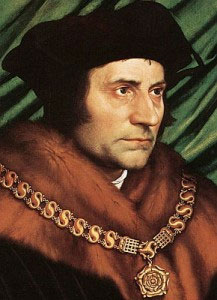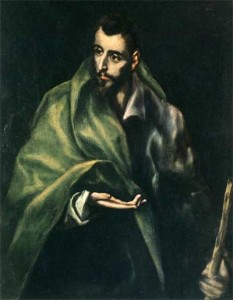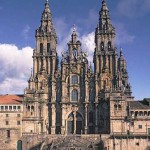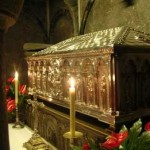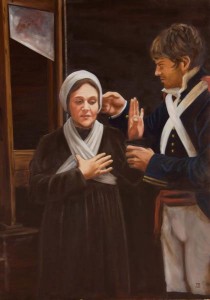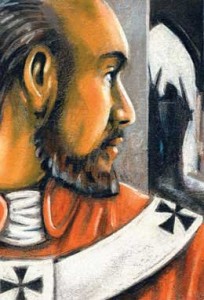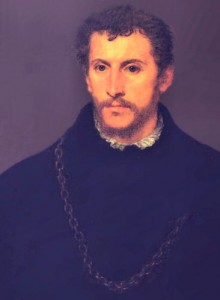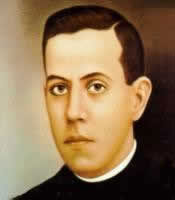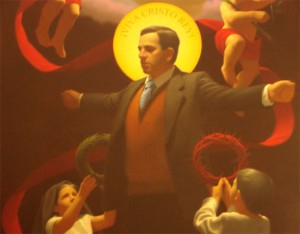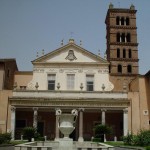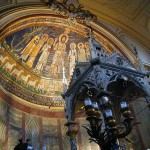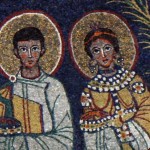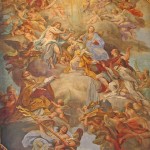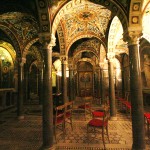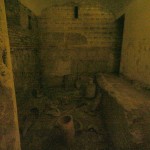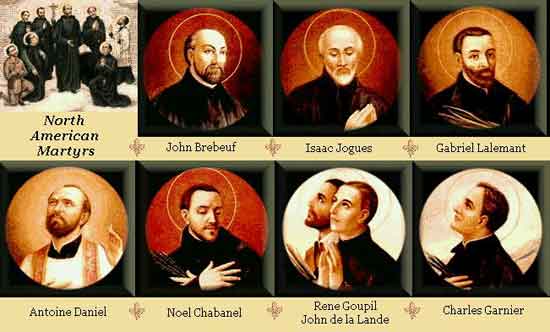I leave it to Omar F. A. Gutierrez to write so well on the life,  times, and death of this great saint.
times, and death of this great saint.
You may perhaps remember a scene from Braveheart with Robert the Bruce and his father the leper.
When his son first brings him news about the rebellion led by William Wallace, a commoner, the father instantly devises a plan by which the Bruce clan can gain favor with the Scots and with the English. You get the feeling that Robert is a bit taken aback by the so easy and cold calculation of his rotted father.
He says,
This Wallace. He doesn’t even have a knighthood. But he fights with passion, and he is clever. He inspires men.
His father replies:
You admire him. Uncompromising men are easy to admire. He has courage. So does a dog. But you must understand this: Edward Longshanks is the most ruthless king ever to sit on the throne of England, and none of us, and nothing of Scotland, will survive unless we are as ruthless, more ruthless, than he.
“Uncompromising men are easy to admire.†There is in this world, and it seems more so today, a habit of admiring the compromising fellow. With the ubiquitous dictatorship of relativism that oppresses so many minds, it only makes sense that the general public would take offense at anyone who dares stand up for something with uncompromising stolidity.
The holder of objective truth claims is – so the sages of Manhattan and Melrose Place tell us – no different than the Nazi who insists on the claim to racial purity or the Islamic bomber who literally does cling to his religion and guns.
For this reason, the figure of St. Thomas More, whose feast it is today, can be such a 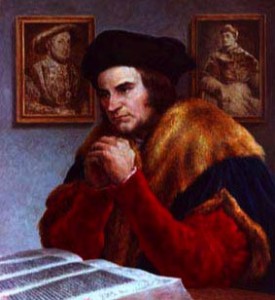 perplexing figure for the modern mind. And even the Catholic who consumes their breakfast whilst pouring over the latest moto proprio can miss this astonishingly great man. I have to admit having skipped over him in my studies, chalking him up with all the other saints and blesseds who gain God’s favor by losing their heads. But St. Thomas More is more than just a martyr.
perplexing figure for the modern mind. And even the Catholic who consumes their breakfast whilst pouring over the latest moto proprio can miss this astonishingly great man. I have to admit having skipped over him in my studies, chalking him up with all the other saints and blesseds who gain God’s favor by losing their heads. But St. Thomas More is more than just a martyr.
He’s an example of such exquisite lack of compromise that he can teach us a great deal about the Catholic Social Doctrine we long to understand and live out. (more…)
Tags: children, england, english reformation, love, martyr, martyrdom, protestant reformation, tudors
This entry was posted on Saturday, June 22nd, 2013 at 6:32 am
You can follow any responses to this entry through the RSS 2.0 feed.
St. John Fisher, 1460-1535
from the Catholic Information Network on St. John Fisher
John Fisher, born at Beverley, Yorkshire, was the son of a prosperous mercer who died in 1477. About 1482 the boy’s mother sent him to Cambridge University where he distinguished himself as a scholar. He was ordained in 1491 on the title of his Fellowship of Michaelhouse (now incorporated in Trinity College). After studying theology for ten years, he took his D.D. in 1501, and was later recognized as one of the leading theologians of Europe.
His university soon discovered his gifts as an administrator; he held in turn the offices of proctor, vice-chancellor and chancellor, and in 1514 he received the unique distinction of being elected chancellor for life. It was in the course of his university duties that, in 1494, he first met the Lady Margaret Beaufort, mother of Henry VII. He became her confessor and advised her on the charitable uses of her great wealth. It was at his suggestion that a preachership was endowed at Cambridge and Readerships in Divinity in both universities. He was largely responsible for her decision to refound and endow Godshouse as Christ’s College, and, after her death in 1509, he carried out her wishes in founding St. John’s College, to which he transferred lands given to him by the Lady Margaret.
He was made bishop of Rochester in 1504, and he ruled that poorest of sees for thirty years; he was a truly pastoral bishop, encouraging his priests by his manner of life and by his interest in their welfare. He was a noted and assiduous preacher, and he did all he could to provide well-instructed priests who could preach to the people.
It was due to his influence that Erasmus was brought to Cambridge as lecturer in Greek. He and Sir Thomas More became close friends of John Fisher, and there is a record of the three being together at Rochester in 1516. Sir Thomas More became High Steward of Cambridge University in 1525. He and John Fisher had been drawn closer together at this period by the call to combat the Lutheran heresy. The bishop wrote his Confutatio (1523) in Latin, a book for theologians by a theologian, which had a wide circulation on
the continent; the layman wrote his Dialogue Concerning Heresies (1528) in English for the common reader. It may be noted that in his sermons and writings against heretics, John Fisher never used the abusive language of contemporary controversy; he relied on reason and persuasion to bring back the prodigals.
The year 1527 was fateful to England, for it was then that Henry VIII took the first steps towards seeking the annulment of his marriage with Catherine of Aragon. She had married his elder brother Arthur in 1501; he died six months later. Catherine always maintained that the marriage had not been consummated. A papal dispensation allowed Henry VIII to marry his brother’s widow in 1509. The lack of a male heir turned his thoughts to the dissolution of his marriage; he argued that the papal dispensation had no validity. Cardinal Wosley was instructed to seek the opinion of John Fisher, whose prestige as a man of holy life and of great learning gave exceptional weight to his views. After studying the problem thoroughly he came to the conclusion that the papal dispensation was valid, and therefore that Henry and Catherine were man and wife in the eyes of the church. From that position he never moved in spite of the pressure brought to bear on him by king and cardinal. He was not content with passive opposition, but in the legatine court set up to try the issue, and from the pulpit, he defended the queen, although he knew that Henry regarded opposition to his will as a form of treason.
An attempt to implicate John Fisher in the fate of the Nun of Kent failed; she had prophesied against the king. A more certain weapon was provided by the Act of Succession of 1534. This declared the king’s marriage to Catherine void, and his subsequent marriage to Anne Boleyn to be lawful; the succession was settled on her children. All had to take an oath accepting the whole Act. When the oath was tendered to
John Fisher he refused to take it; so did Sir Thomas More. Both were prepared to accept the succession as determined by Parliament, but not that part of the Act which implied a denial of the pope’s authority, inasmuch as it declared the papal dispensation invalid.
On April 17th, 1534 Bishop John Fisher and Sir Thomas More were committed to the Tower. They were kept apart.
John Fisher was sixty-five years of age when he was imprisoned; he was suffering from a wasting sickness and was clearly nearing his end. Nothing shows the king’s vindictiveness more than his relentless persecution of this aged man stricken by a fatal illness. On May 20th, 1535, the pope created John Fisher Cardinal-priest of the title of St. Vitalis. This so infuriated the king that he hurried forward the proceedings against the new cardinal. (more…)
Tags: bishop, english reformation, John Fisher, martyr, martyrdom, martyrs of england, priests, protestant reformation
This entry was posted on Saturday, June 22nd, 2013 at 6:00 am
You can follow any responses to this entry through the RSS 2.0 feed.
BENEDICT XVI
GENERAL AUDIENCE
Wednesday, 21 June 2006
James, the Greater
We are continuing the series of portraits of the Apostles chosen directly by Jesus during his earthly life. We have spoken of St Peter and of his brother, Andrew. Today we meet the figure of James. The biblical lists of the Twelve mention two people with this name: James, son of Zebedee, and James, son of Alphaeus (cf. Mk 3: 17,18; Mt 10: 2-3), who are commonly distinguished with the nicknames “James the Greater” and “James the Lesser”.
These titles are certainly not intended to measure their holiness, but simply to state the different importance they receive in the writings of the New Testament and, in particular, in the setting of Jesus’ earthly life. Today we will focus our attention on the first of these two figures with the same name.
The name “James” is the translation of Iakobos, the Graecised form of the name of the famous Patriarch, Jacob. The Apostle of this name was the brother of John and in the above-mentioned lists, comes second, immediately after Peter, as occurs in Mark (3: 17); or in the third place, after Peter and Andrew as in the Gospels of Matthew (10: 2) and Luke (6: 14), while in the Acts he comes after Peter and John (1: 13). This James belongs, together with Peter and John, to the group of the three privileged disciples whom Jesus admitted to important moments in his life.
Since it is very hot today, I want to be brief and to mention here only two of these occasions. James was able to take part, together with Peter and John, in Jesus’ Agony in the Garden of Gethsemane and in the event of Jesus’ Transfiguration. Thus, it is a question of situations very different from each other: in one case, James, together with the other two Apostles, experiences the Lord’s glory and sees him talking to Moses and Elijah, he sees the divine splendour shining out in Jesus.
On the other occasion, he finds himself face to face with suffering and humiliation, he sees with his own eyes how the Son of God humbles himself, making himself obedient unto death. The latter experience was certainly an opportunity for him to grow in faith, to adjust the unilateral, triumphalist interpretation of the former experience: he had to discern that the Messiah, whom the Jewish people were awaiting as a victor, was in fact not only surrounded by honour and glory, but also by suffering and weakness. Christ’s glory was fulfilled precisely on the Cross, in his sharing in our sufferings.
This growth in faith was brought to completion by the Holy Spirit at Pentecost, so that James, when the moment of supreme witness came, would not draw back. Early in the first century, in the 40s, King Herod Agrippa, the grandson of Herod the Great, as Luke tells us, “laid violent hands upon some who belonged to the Church. He had James, the brother of John, killed by the sword” (Acts 12: 1-2).
The brevity of the news, devoid of any narrative detail, reveals on the one hand how normal it was for Christians to witness to the Lord with their own lives, and on the other, that James had a position of relevance in the Church of Jerusalem, partly because of the role he played during Jesus’ earthly existence.
A later tradition, dating back at least to Isidore of Seville, speaks of a visit he made
to Spain to evangelize that important region of the Roman Empire. According to another tradition, it was his body instead that had been taken to Spain, to the city of Santiago de Compostela. As we all know, that place became the object of great veneration and is still the destination of numerous pilgrimages, not only from Europe but from the whole world. This explains the iconographical representation of St James with the pilgrim’s staff and the scroll of the Gospel in hand, typical features of the travelling Apostle dedicated to the proclamation of the “Good News” and characteristics of the pilgrimage of Christian life.
Consequently, we can learn much from St James: promptness in accepting the Lord’s call even when he asks us to leave the “boat” of our human securities, enthusiasm in following him on the paths that he indicates to us over and above any deceptive presumption of our own, readiness to witness to him with courage, if necessary to the point of making the supreme sacrifice of life.
Thus James the Greater stands before us as an eloquent example of generous adherence to Christ. He, who initially had requested, through his mother, to be seated with his brother next to the Master in his Kingdom, was precisely the first to drink the chalice of the passion and to share martyrdom with the Apostles.
And, in the end, summarizing everything, we can say that the journey, not only exterior but above all interior, from the mount of the Transfiguration to the mount of the Agony, symbolizes the entire pilgrimage of Christian life, among the persecutions of the world and the consolations of God, as the Second Vatican Council says. In following Jesus, like St James, we know that even in difficulties we are on the right path.
Tags: apostle, martyr, pilgrimage, pope benedict xvi
This entry was posted on Wednesday, July 25th, 2012 at 8:49 am
You can follow any responses to this entry through the RSS 2.0 feed.
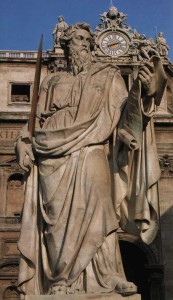
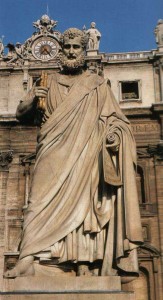 This is a FANTASTIC summation of the lives of Peter and Paul in the life of the early Church by Vatican Radio…don’t miss it!
This is a FANTASTIC summation of the lives of Peter and Paul in the life of the early Church by Vatican Radio…don’t miss it!
Why Peter and Paul ?
Wherever you go in Rome you always see Saint Peter and Saint Paul linked together.
Their feast day too is celebrated on the same day . Shouldn’t they each have their own feast day?
The irony is that they fought mightily in their lifetime and not just about trivial things but about matters that went to the very heart of what Christianity is all about.
Listen to Scripture scholar Mark Benedict Coleridge , Archbishop of Canberra and
Goulburn:[powerpress = “Vatican-Radio”]
Tags: acts of the apostles, apostles, catholic, catholic podcast, catholic prayer, cathollc spirituality, early church, martyr, martyrdom, Peter and Paul, Saint Peter, st peter, st. paul, sts. peter and paul, vatican radio
This entry was posted on Friday, June 29th, 2012 at 5:57 am
You can follow any responses to this entry through the RSS 2.0 feed.
Beatification of Sister Marguerite Rutan,
June 19, 2011
From the Daughter of Charity of St. Vincent de Paul website:
“The lives of the saints are not limited to their earthly biographies but also include their being and working in God after death. In the saints one thing becomes clear: those who draw near to God do not withdraw from men, but rather become truly close to them.â€(Deus Caritas est 42).
In February 2011 we published a short article on Sister Marguerite Rutan, Daughter of Charity and martyr (see www.filles-de-la-charite.org/en/news). As her beatification approaches we invite you to learn more about her life. Who is this new example of Vincentian holiness?
A presentation of her life:
Marguerite Rutan was born on 23 April 1736 in Metz in Lorraine and was baptized the same day. Marguerite was the 8th of 15 children. Marie Forat, her mother, was very Christian and her father, Charles Gaspard Rutan was an honest and courageous workman. With them she learned to live her life as a gift from God.
Her father introduced her to mathematics and linear design. Soon she was able to keep the accounts of his business. She helped with all her family until she was 21 years old.
She had the profound conviction she was being called by Jesus. With Him she looked for a way to give herself to the service of those who were poor.
In 1756, Marguerite Rutan entered the Company of the Daughters of Charity to be near those who were suffering, marginalized or excluded. She wanted to serve them. Following Christ she encouraged charity in those around her. For over 20 years she placed everything she received from God and others at the service of the poorest of the poor, no matter where she was sent by her superiors.
In 1779 she was sent to serve in the Hospital of Dax. Sr. Marguerite and her Sisters worked for 10 years relating with the townspeople. The Sisters were admired and respected.
In 1789 the troubling period of the Revolution began. It profoundly changed the country and personally touched Sr. Marguerite with suffering and death (April 9, 1794). Her faithfulness to Christ and the Church lead her to martyrdom. The life of Sr. Marguerite was anchored in the person of Christ and his Word. Each day she profoundly encountered the love of Christ which drew her to serve as He served.
Following Christ, servant of her brothers and sisters, kneeling to wash their feet, Sr. Marguerite gave her life to serve the poor and the sick and building brotherhood with all.
Following Christ, servant of the will of the Father, Sr. Marguerite based her life on the Gospel, desiring only one thing: to do the will of God.
Following Christ, servant of the suffering, despised, persecuted, Sr. Marguerite abandoned herself totoally to God. During the revolutionary turmoil, she showed the extremity of her love.
Interesting links:
Marguerite Rutan: A little history of her life
Tags: Blessed Marguerite Rutan, catholic, catholic podcast, catholic prayer, cathollc spirituality, daughters of charity, france, french revolution, Marguerite Rutan, martyr, martyrdom, Sister Marguerite Rutan
This entry was posted on Thursday, June 21st, 2012 at 1:16 pm
You can follow any responses to this entry through the RSS 2.0 feed.
It’s been a fantastic journey to enter into the life Dietrich Bonhoeffer through the writing of Eric Metaxas. “Bonhoeffer: Pastor, Martyr, Prophet, Spy”  is a deeply moving telling of the life of the German Lutheran theologian and pastor who would face the leviathan of evil known as the Third Reich in Nazi Germany. In reading this work, I was reminded of the young man several years ago in Tiananmenin Square who stood before the tank during the protests. It doesn’t surprise me that Archbishop Chaput would highly recommended this book as well as the “witness” of this Christian man who was a voice for those who could not speak. He did what St. Paul called us all to do…to stand. Eric Metaxas does a great job bringing this biography to life and giving us the greater context
is a deeply moving telling of the life of the German Lutheran theologian and pastor who would face the leviathan of evil known as the Third Reich in Nazi Germany. In reading this work, I was reminded of the young man several years ago in Tiananmenin Square who stood before the tank during the protests. It doesn’t surprise me that Archbishop Chaput would highly recommended this book as well as the “witness” of this Christian man who was a voice for those who could not speak. He did what St. Paul called us all to do…to stand. Eric Metaxas does a great job bringing this biography to life and giving us the greater context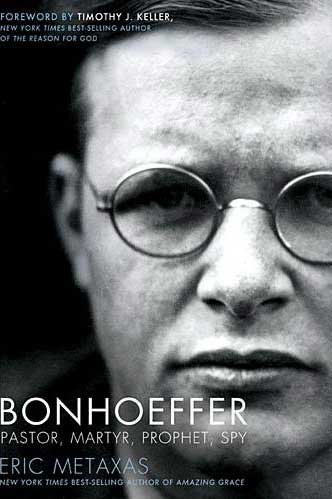 of his witness.
of his witness.
[powerpress]
Visit www.ericmetaxas.com to learn more
Here is another interview that Bruce and I had  wi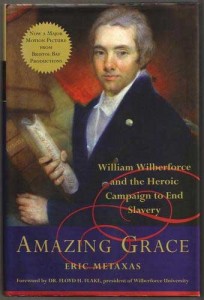 th Eric about William Wilberforce in his book “Amazing Grace” [powerpress url=”http://www.old.discerninghearts.com/Morning%20Show/Eric%20Metaxas%20Amazing%20Grace.mp3″]Download(right click  & choose “Save Link As”)
th Eric about William Wilberforce in his book “Amazing Grace” [powerpress url=”http://www.old.discerninghearts.com/Morning%20Show/Eric%20Metaxas%20Amazing%20Grace.mp3″]Download(right click  & choose “Save Link As”)
Tags: archbishop chaput, catholic, catholic podcast, catholic prayer, cathollc spirituality, dietrich bonhoeffer, eric metaxas, lutheran theologian, martyr, nazi germany, third reich, william wilberforce
This entry was posted on Friday, February 10th, 2012 at 12:51 am
You can follow any responses to this entry through the RSS 2.0 feed.
And what would happen next………
.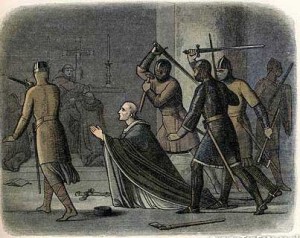
A strong man who wavered for a moment, but then learned one cannot come to terms with evil and so became a strong churchman, a martyr and a saint—that was Thomas Becket, archbishop of Canterbury, murdered in his cathedral on December 29, 1170.
His career had been a stormy one. While archdeacon of Canterbury, he was made chancellor of England at the age of 36 by his friend King Henry II. When Henry felt it advantageous to make his chancellor the archbishop of Canterbury, Thomas gave him fair warning: he might not accept all of Henry’s intrusions into Church affairs. Nevertheless, he was made archbishop (1162), resigned his chancellorship and reformed his whole way of life!
Troubles began. Henry insisted upon usurping Church rights. At one time, supposing some conciliatory action possible, Thomas came close to compromise. He momentarily approved the Constitutions of Clarendon, which would have denied the clergy the right of trial by a Church court and prevented them from making direct appeal to Rome. But Thomas rejected the Constitutions, fled to France for safety and remained in exile for seven years. When he returned to England, he suspected it would mean certain death. Because Thomas refused to remit censures he had placed upon bishops favored by the king, Henry cried out in a rage, “Will no one rid me of this troublesome priest!†Four knights, taking his words as his wish, slew Thomas in the Canterbury cathedral.
Thomas Becket remains a hero-saint down to our own times. From Saint of the Day
For a greater telling of this saint’s life – EWTN Library
Note: T. S. Eliot wrote a play — “Murder in the Cathedral” — about his life, and a movie — “Becket” (1964) — starring Peter O’Toole and Richard Burton has been made, too
Prayer for St. Thomas a Becket
Taken from the Roman Missal.
O God, for the sake of whose Church the glorious Bishop Thomas fell by the sword of ungodly men: grant, we beseech Thee, that all who implore his aid, may obtain the good fruit of his petition. Through our Lord Jesus Christ, Who livest and reignest with Thee in the unity of the Holy Spirit, forever and ever. Amen.
Tags: archbishop of Canterbury, Archishop of Canterbury, Canterbury cathedral, catholic, catholic podcast, catholic prayer, cathollc spirituality, Church, england, Henry II, martyr, matyrdom, middle ages, St. Thomas Becket, Thomas Becket
This entry was posted on Thursday, December 29th, 2011 at 5:19 am
You can follow any responses to this entry through the RSS 2.0 feed.
Trial and execution
Committed to the Tower of London, he was questioned in the presence of Queen Elizabeth, who asked him if he acknowledged her to be the true Queen of England. He replied she was, and she offered him wealth and dignities, but on condition of rejecting his Catholic faith, which he refused to accept. He was kept a long time in prison and reputedly racked twice. Despite the effect of a false rumour of retraction and a forged confession, his adversaries summoned him to four public conferences (September 1, 18, 23 and 27, 1581). Although still suffering from his ill treatment, and allowed neither time nor books for preparation, he reportedly conducted himself so easily and readily that he won the admiration of most of the audience. Tortured again on October 31, he was indicted at Westminster on a charge of having conspired, along with others, in Rome and Reims to raise a sedition in the realm and dethrone the Queen.
Edmund Campion, in a 1631 print.Campion was sentenced to death as a traitor. He answered: “In condemning us, you condemn all your own ancestors, all our ancient bishops and kings, all that was once the glory of England — the island of saints, and the most devoted child of the See of Peter.” He received the death sentence with the Te Deum laudamus. After spending his last days in prayer he was led with two companions, Ralph Sherwin and Alexander Briant, to Tyburn where the three sainted martyrs were hanged, drawn and quartered on December 1, 1581. He was 41 years of age.
Veneration and Feast Day
Edmund Campion was beatified by Pope Leo XIII on December 9, 1886. Blessed Edmund Campion was canonized nearly eighty-four years later in 1970 by Pope Paul VI as one of the Forty Martyrs of England and Wales with a common feast day of May 4. His feast day is celebrated on December 1, the day of his martyrdom.
The actual ropes used in his execution are now kept in glass display tubes at Stonyhurst College in Lancashire; each year they are placed on the altar of St Peter’s Church for Mass to celebrate Campion’s feast day—which is always a holiday for the school. – wiki
A Daily Prayer of St. Edmund
“I have made a free oblation of myself
to your Divine Majesty,
both of life and of death,
and I hope that
you will give me
grace and force to perform.
This is all I desire. Amen.”
-St. Edmund Campion
Tags: Blessed Edmund Campion, catholic, catholic podcast, catholic prayer, cathollc spirituality, death, edmund campion, england, feast day, Feast Day Edmund Campion, martyr, martyrdom, martyrs of england, queen elizabeth, Queen of England, saints
This entry was posted on Thursday, December 1st, 2011 at 12:02 am
You can follow any responses to this entry through the RSS 2.0 feed.
Viva Cristo Rey
take a look…you won’t be disappointed
and maybe moved to learn about this extradodinary man…saint
According to one of Fr. Pro’s biographers, Rec. M.D. Forrest, M.S.C., the following was composed shortly before his death:
Does our life become from day to day more painful, more oppressive, more replete with afflictions? Â Blessed be He a thousand times who desires it so. If life be harder, love makes it also stronger, and only this love, grounded on suffering, can carry the Cross of my Lord Jesus Christ. Love without egotism, without relying on self, but enkindling in the depth of the heart an ardent thirst to love and suffer for all those around us: a thirst that neither misfortune nor contempt can extinguish… I believe, O Lord; but strengthen my faith… Heart of Jesus, I love Thee; but increase my love. Heart of Jesus, I trust in Thee; but give greater vigor to my confidence. Heart of Jesus, I give my heart to Thee; but so enclose it in Thee that it may never be separated from Thee. Heart of Jesus, I am all Thine; but take care of my promise so that I may be able to put it in practice even unto the complete sacrifice of my life.
Tags: Blessed Miguel Agust, Blessed Miguel Pro, catholic, catholic podcast, catholic prayer, cathollc spirituality, heart, Heart of Jesus, Jesus, Lord Jesus Christ, love, M.D. Forrest, martyr
This entry was posted on Wednesday, November 23rd, 2011 at 12:03 am
You can follow any responses to this entry through the RSS 2.0 feed.
St. Cecilia, her story is an extraordinary one of faithulness and commitment. Some would have you believe it was all “legend”, but the discovery of her incorrupt body in 1599 would bear otherwise. It seems to me the Lord is encouraging us to believe the witness of this courageous virgin martyr.
In St. Cecilia’s in Rome, Â I had one of the most peaceful and prayerful experiences while on pilgrimage to the “City of the Saints”.
It is said that Saint Cecilia was born of a patrician family in Rome and raised as a Christian. She wore a coarse horsehair garment beneath her clothes of rank, fasted, and vowed herself to God.
 Against her will she was married by her father to a young, pagan patrician named Valerian. While everyone sang and danced at their wedding, Cecilia sat apart, saying only the Psalms. Valerian turned out to be a man of great understanding. On their wedding night, she told Valerian, “I have an angel of God watching over me. If you touch me in the way of marriage, he will be angry and you will suffer. But if you respect my maidenhood, he will love you as he loves me.”
Against her will she was married by her father to a young, pagan patrician named Valerian. While everyone sang and danced at their wedding, Cecilia sat apart, saying only the Psalms. Valerian turned out to be a man of great understanding. On their wedding night, she told Valerian, “I have an angel of God watching over me. If you touch me in the way of marriage, he will be angry and you will suffer. But if you respect my maidenhood, he will love you as he loves me.”
Valerian replied, “Show me this angel.” She told him that if he believed in the living and one true God and was baptized, he would see the angel. Thus, she persuaded Valerian to respect her vow of virginity.
He was impressed and attracted by his wife’s Christian graces, and so Valerian was baptized by Pope Saint Urban (which would be c. 222-230). When he returned to Cecilia, he found her standing by the side of an angel as she promised. The angel told him: “I have a crown of flowers for each of you. They have been sent from paradise as a sign of the life you are both to lead. If you are faithful to God, He will reward you with the everlasting perfumes of heaven.”
The angel then crowned Cecilia with roses, and Valerian with a wreath of lilies. The delightful fragrance of the flowers filled the whole house. At this point Valerian’s brother, Tiburtius, appeared. He, too, was offered salvation if he would renounce false gods. Cecilia converted him, and he was baptized.
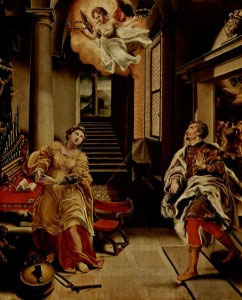 From that time the two young men dedicated themselves to good works. Because of their ardor in burying the bodies of martyred Christians, they were arrested. The prefect Almachius told them that if they would sacrifice to the gods, they could go free. They refused, and Valerian rejoiced when he was handed over to be scourged.
From that time the two young men dedicated themselves to good works. Because of their ardor in burying the bodies of martyred Christians, they were arrested. The prefect Almachius told them that if they would sacrifice to the gods, they could go free. They refused, and Valerian rejoiced when he was handed over to be scourged.
The prefect wanted to give them another chance, but his assessor warned him that they would simply use the interim to give away their possessions so that they couldn’t be confiscated. They were beheaded in Pagus Triopius, four miles from Rome. With them was an officer named Maximus, who had declared himself a Christian after witnessing their fortitude.
Cecilia buried the three and then decided to turn her home into a place of worship. Her religion was discovered and she herself asked to refute her faith. She converted those who were sent to convince her to sacrifice to the gods. When Pope Urban visited her at home, he baptized over 400 people.
In court, Almachius debated with her for some time. She was sentenced to be suffocated to death in the bathroom of her own house. The furnace was fed seven times its normal amount of fuel, but the steam and heat failed to stifle her. 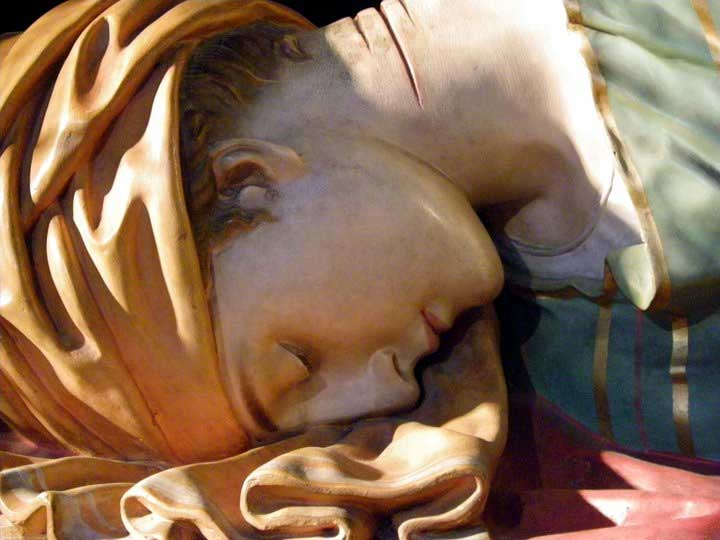 A soldier sent to behead her struck at her neck three times, and she was left dying on the floor. She lingered for three days, during which time the Christians thronged to her side, and she formally made over her house to Urban and committed her household to his care.
A soldier sent to behead her struck at her neck three times, and she was left dying on the floor. She lingered for three days, during which time the Christians thronged to her side, and she formally made over her house to Urban and committed her household to his care.
She was buried next to the papal crypt in the catacombs of Saint Callixtus. In 817, Pope Saint Paschal I discovered her grave, which had been concealed 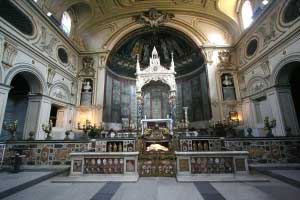 from the Lombard invader Aistulf in 756, and translated her body to beneath the main altar of what was later called the titulus Sanctae Caeciliae, which translates as “the church founded by a lady named Cecilia.” In 1599, during the renovation of the church, Cardinal Sfondrati opened her tomb and found her holy remains incorrupt. Even the green and gold of her rich robe had not been injured by time. Thousands had the privilege of seeing her in her coffin, and many have been blessed by miracles. The body disintegrated quickly after meeting with the air.
from the Lombard invader Aistulf in 756, and translated her body to beneath the main altar of what was later called the titulus Sanctae Caeciliae, which translates as “the church founded by a lady named Cecilia.” In 1599, during the renovation of the church, Cardinal Sfondrati opened her tomb and found her holy remains incorrupt. Even the green and gold of her rich robe had not been injured by time. Thousands had the privilege of seeing her in her coffin, and many have been blessed by miracles. The body disintegrated quickly after meeting with the air.
Under the high altar in Saint Cecilia’s Church is a beautiful marble statue by Maderna portraying the “martyr” bathed in her own blood as she fell after the stroke of the 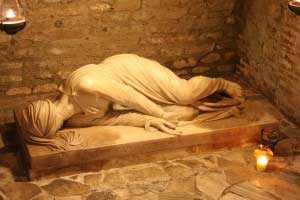 sword. A replica of this statue occupies the the original resting place of the saint in the catacomb of Callixtus. Other artists were allowed to paint pictures of her after her tomb was opened.
sword. A replica of this statue occupies the the original resting place of the saint in the catacomb of Callixtus. Other artists were allowed to paint pictures of her after her tomb was opened.
Until the middle ages, Pope Saint Gregory had been the patron of music and musicians, but when the Roman Academy of Music was established in 1584, it was put under the protection of Saint Cecilia; thus, her patronage of music originated. Dryden wrote a “Song for Saint Cecilia Day” and Pope an “Ode for Music on Saint Cecilia Day.”
Valerian, Tiburtius, and Maximus are historical characters; they were Roman martyrs, buried in the cemetery of Praetextatus, but nothing else is known of them. Her story was the basis for the Second Nun’s Tale in Chaucer’s Canterbury Tales.
St. Cecilia is regarded as the patroness of music [because of the story that she heard heavenly music in her heart when she was married], and is represented in art with an organ or organ-pipes in her hand.– From The Lives of the Saints by the Rev. S. Baring-Gould, M.A., published in 1914 in Edinburgh.
Dear Saint Cecilia, one thing we know for certain about you is that you became a heroic martyr in fidelity to your divine Bridegroom.
We do not know that you were a musician but we are told that you heard Angels sing.
Inspire musicians to gladden the hearts of people by filling the air with God’s gift of music and reminding them of the divine Musician who created all beauty.
Amen.
Tags: angel, catholic, catholic podcast, catholic prayer, cathollc spirituality, churches in rome, martyr, music, prayer, rome, st cecilia, valerian, virgin martyr, virginity
This entry was posted on Tuesday, November 22nd, 2011 at 12:32 am
You can follow any responses to this entry through the RSS 2.0 feed.
Blessed John Paul II reflection on the NMA:
The North American Martyrs, then, gave up their lives for the sake of the Gospel – in order to bring the faith to the native people whom they served. In fact, we are told that their faith was so strong that they yearned and prayed for the grace of martyrdom. Let us recall for a moment these heroic saints who are honoured in this place and who have left us a precious heritage.
Six of them were Jesuit priests from France: Jean de Brébeuf, Isaac Jogues, Gabriel Lalemant, Antoine Daniel, Charles Garnier and Noël Chabanel. Fired with love for Christ and inspired by Saint Ignatius of Loyola, Saint Francis Xavier and other great saints of the Society of Jesus, these priests came to the New World to proclaim the Gospel of Jesus Christ to the native peoples of this land. And they persevered to the end despite difficulties of every sort.
Two lay brothers were part of the missionary group: René Goupil and Jean de la Lande. With no less courage and fervour, they assisted the priests in their labours, showed great compassion and care for the Indians, and, laying down their lives, won for themselves the martyr’s crown.
And as these missionaries laid down their lives, they looked forward to a day when the native people would enjoy full maturity and exercise leadership in their Church. St. John de Brébeuf dreamed of a Church fully Catholic and fully Huron as well.
…
And today we are grateful for the part that the native peoples play, not only in the multicultural fabric of Canadian society, but in the life of the Catholic Church. Christ himself is incarnate in his Body, the Church. And through her action, the Church desires to assist all people “to bring forth from their own living tradition original expressions of Christian life, celebration and thought” (Ioannis Pauli PP. II, Catchesi Tradendae, 53).
Thus the one faith is expressed in different ways. There can be no question of adulterating the word of God or of emptying the Cross of its power, but rather of Christ animating the very centre of all culture. Thus, not only is Christianity relevant to the Indian people, but Christ, in the members of his Body, is himself Indian.
And the revival of Indian culture will be a revival of those true values which they have inherited and which are purified and ennobled by the Revelation of Jesus Christ. Through his Gospel Christ confirms the native peoples in their belief in God, their awareness of his presence, their ability to discover him in creation, their dependence on him, their desire to worship him, their sense of gratitude for the land, their responsible stewardship of the earth, their reverence for all his great works, their respect for their elders. The world needs to see these values – and so many more that they possess – pursued in the life of the community and made incarnate in a whole people.
Finally, it is in the Eucharistic sacrifice that Christ, joined with his members, offers up to his Father all that makes up their lives and cultures. In his Sacrifice he consolidates all his people in the unity of his Church and calls us all to reconciliation and peace.
As we go forward, let us commend ourselves to the intercession of the North American Martyrs, to Blessed Kateri Tekakwitha, Saint Joseph, Patron of Canada, and all the Saints, together with Mary the Queen of Saints. And in union with the whole Church – in the richness of her diversity and in the power of her unity – let us all proclaim by the witness of our own lives that “neither death nor life… nor any created thing, can ever come between us and the love of God made visible in Christ Jesus our Lord” (Rom. 8, 38-39).
Tags: catholic, catholic church, catholic podcast, catholic prayer, cathollc spirituality, jesuits, martyr, martyrdom, native peoples, The North American Martyrs
This entry was posted on Wednesday, October 19th, 2011 at 10:12 am
You can follow any responses to this entry through the RSS 2.0 feed.
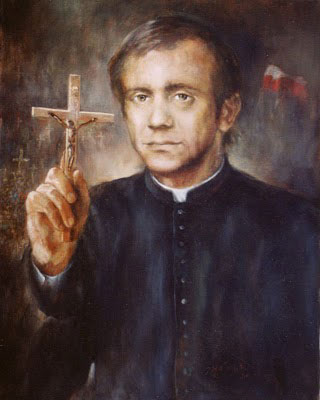 From Pope Benedict XVI, an excerpt
From Pope Benedict XVI, an excerpt
Another figure I wish to remember: Fr Jerzy Popiełuszko, a priest and martyr who was proclaimed Blessed in Warsaw precisely last Sunday. He exercised his generous and courageous ministry beside all those who were working for freedom, for the defence of life and for its dignity. His work at the service of goodness and truth was a sign of contradiction for the regime governing Poland at the time. Love of the Heart of Christ led him to give his life and his witness was the seed of a new springtime in the Church and in society. If we look at history, we can note how many pages of authentic spiritual and social renewal were written with the crucial contribution of Catholic priests, motivated solely by passion for the Gospel and for human beings and for their true freedom, both religious and civil. How many initiatives of integral human promotion have been born from the intuition of a priestly heart!
Dear brothers and sisters, let us entrust all the priests in the world to the Immaculate Heart of Mary, whose liturgical Memorial we celebrated yesterday, so that they may continue with the power of the Gospel to build everywhere the civilization of love.
Tags: Blessed Jerzy Popieluszko, catholic, catholic podcast, catholic prayer, cathollc spirituality, martyr, martyrdom, pope benedict xvi
This entry was posted on Wednesday, October 19th, 2011 at 7:47 am
You can follow any responses to this entry through the RSS 2.0 feed.
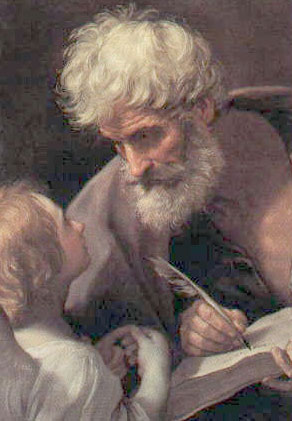 St. Matthew, one of the twelve Apostles, is the author of the first Gospel.Son of Alphaeus, he lived at Capenaum on Lake Genesareth. He was a Roman tax collector, a position equated with collaboration with the enemy by those from whom he collected taxes. Jesus’ contemporaries were surprised to see the Christ with a traitor, but Jesus explained that he had come “not to call the just, but sinners.†Matthew’s Gospel is given pride of place in the canon of the New Testament, and was written to convince Jewish readers that their anticipated Messiah had come in the person of Jesus. He preached among the Jews for 15 years; his audiences may have included the Jewish enclave in Ethiopia, and places in the East.
St. Matthew, one of the twelve Apostles, is the author of the first Gospel.Son of Alphaeus, he lived at Capenaum on Lake Genesareth. He was a Roman tax collector, a position equated with collaboration with the enemy by those from whom he collected taxes. Jesus’ contemporaries were surprised to see the Christ with a traitor, but Jesus explained that he had come “not to call the just, but sinners.†Matthew’s Gospel is given pride of place in the canon of the New Testament, and was written to convince Jewish readers that their anticipated Messiah had come in the person of Jesus. He preached among the Jews for 15 years; his audiences may have included the Jewish enclave in Ethiopia, and places in the East.
 Listen to none other than Mark Hart the Bible Geek about the great work of St. Matthew…of course, the Gospel according to St. Matthew[powerpress]
Listen to none other than Mark Hart the Bible Geek about the great work of St. Matthew…of course, the Gospel according to St. Matthew[powerpress]
Personal note, my favorite Matthew passage (from Chapter 25): “When the Son of Man comes in his glory, and all the angels with him, he will sit upon his glorious throne, and all the nations will be assembled before him. And he will separate them one from another, as a shepherd separates the sheep from the goats. He will place the sheep on his right and the goats on his left. Then the king will say to those on his right, ‘Come, you who are blessed by my Father. Inherit the kingdom prepared for you from the foundation of the world. For I was hungry and you gave me food, I was thirsty and you gave me drink, a stranger and you welcomed me, naked and you clothed me, ill and you cared for me, in prison and you visited me.‘ Then the righteous will answer him and say, ‘Lord, when did we see you hungry and feed you, or thirsty and give you drink? When did we see you a stranger and welcome you, or naked and clothe you? When did we see you ill or in prison, and visit you?’ And the king will say to them in reply, ‘Amen, I say to you, whatever you did for one of these least brothers of mine, you did for me.’ Then he will say to those on his left, ‘Depart from me, you accursed, into the eternal fire prepared for the devil and his angels. For I was hungry and you gave me no food, I was thirsty and you gave me no drink, a stranger and you gave me no welcome, naked and you gave me no clothing, ill and in prison, and you did not care for me.’ Then they will answer and say, ‘Lord, when did we see you hungry or thirsty or a stranger or naked or ill or in prison, and not minister to your needs?’ He will answer them, ‘Amen, I say to you, what you did not do for one of these least ones, you did not do for me.’ And these will go off to eternal punishment, but the righteous to eternal life.”
Tags: apostle, catholic, catholic podcast, catholic prayer, cathollc spirituality, gospel of matthew, levi, martyr, st matthew, tax collectors
This entry was posted on Wednesday, September 21st, 2011 at 12:23 am
You can follow any responses to this entry through the RSS 2.0 feed.
Tags: catholic, catholic podcast, catholic prayer, cathollc spirituality, martyr, martyrdom
This entry was posted on Thursday, June 30th, 2011 at 6:09 am
You can follow any responses to this entry through the RSS 2.0 feed.
In my book, every missionary is great. It takes a great amount of courage and zeal, along with a great deal of faith, hope, and love, to proclaim Christ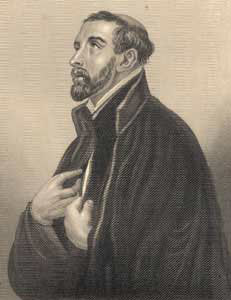 crucified to the world no matter what age you live in, no matter where you travel…whether next door or to a far away land. One of those who has inspired so many is St. Francis Xavier. Omar Gutierrez does another fine job bringing this saint’s witness deeper into our hearts….
crucified to the world no matter what age you live in, no matter where you travel…whether next door or to a far away land. One of those who has inspired so many is St. Francis Xavier. Omar Gutierrez does another fine job bringing this saint’s witness deeper into our hearts….
For the Love of Neighbor…
by Omar F. A. Gutierrez 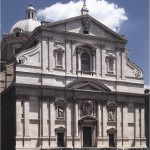 Along a rather busy street in Rome, as one walks along with various-colored motorini passing by in the typical Italian nonchalance, there stands a rather impressive façade of a Church. Churches in Rome are not rarities. Edifices of worship, shrines and even bits of images of the Blessed Virgin dot the city’s corners and crevices throughout. Here, though, with buildings rising tightly upward, is a church with a piazza that stands resolute. The Church is named after Jesus and is referred to by the Italian Gesù.
Along a rather busy street in Rome, as one walks along with various-colored motorini passing by in the typical Italian nonchalance, there stands a rather impressive façade of a Church. Churches in Rome are not rarities. Edifices of worship, shrines and even bits of images of the Blessed Virgin dot the city’s corners and crevices throughout. Here, though, with buildings rising tightly upward, is a church with a piazza that stands resolute. The Church is named after Jesus and is referred to by the Italian Gesù.
Inside the Gesù, amidst the distracting busyness of the Baroque interior, one will find the remains of St. Ignatius of Loyola, the punctilious and perceptive Spaniard who founded the order known as the Society of Jesus, the Jesuits. Across the nave, though, is an oddly obvious glass display case gilt with gold and silver. Above this floats the golden form of an angel whose wings and flowing robes give a good deal of attention to the case, for inside the case, in that only-too-Catholic fashion, is… a forearm.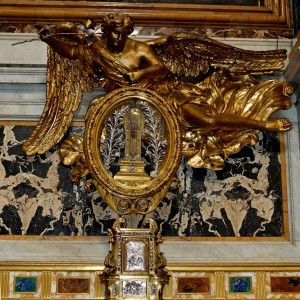
The forearm belonged, or I suppose I should say that it still belongs to another Spaniard who met St. Ignatius at the University of Paris whilst the two of them studied theology. The forearm is on display not in mere virtue of its owner’s friendship with Ignatius. It is on display because its owner, St. Francis Xavier, was one of the most successful missionaries in the history of Christianity. That forearm, black and no doubt by now quite brittle, baptized more souls than perhaps any since the early baptisms of thousands one reads about in the Scriptures.
St. Francis Xavier was born in 1506. When he met St. Ignatius of Loyola, it did not take long for him and five others to join Ignatius in 1534 and be those magnificent seven souls to start the Jesuit order that would transform the world. Nor did it take long, after their order had found some grounding, for St. Francis to be sent by St. Ignatius to go and preach to the world, as Jesus had commanded. St. Francis and his companions, Fr. Paul of Camarino and Francis Mansilhas, sailed from Portugal for India in 1541.
The story of his work in India is dazzling. Certainly Christianity had already been in parts of India, and been there for over a thousand years. However, large swaths of the land were still not evangelized, and anyway the Christians there needed the catechetical and spiritual support of ones like St. Francis, who traveled extensively regardless of danger, time, or geography. What is more astonishing is that the zeal which St. Francis held in that fiery heart of his was not quenched by the successes of India, Ceylon, and the nearby regions. St. Francis heard of a land in which Christianity had never come, Japan, and was compelled to do something about it.
In 1549, he and some companions set out for Japan and landed in Kagoshima. In a year they had 100 converts. Considering this a pittance, Francis pressed onward. At Hirado he was well received and converts came in the droves. His forearm tired at the effort of so many baptisms. Still he pressed on. By the time he left Japan in 1551 at least 2,000 Japanese had been baptized. But there were more lands to be given the Gospel.
I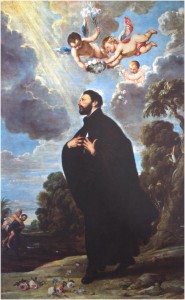 n August of 1552, St. Francis was off again, this time to China. Unfortunately, he fell ill there and died a short time after, on December 3, 1552.
n August of 1552, St. Francis was off again, this time to China. Unfortunately, he fell ill there and died a short time after, on December 3, 1552.
Some of the marks of St. Francis’ story are truly wonderful to relate, not the least of these is the sheer number of baptisms he performed during his eleven years of service in Asia. Modern estimates of his work put him at about 30,000 baptisms. To put that in perspective a bit, that means that St. Francis Xavier would have baptized between 7 and 8 people every day for eleven straight years.
Though he worked to learn the many languages of the lands in which he preached, of course keeping in mind that he would have already known Basque, Spanish, Latin, French, Italian, and Portuguese, he did not have the gift of tongues. The languages he picked up on in India and elsewhere were the result of grueling work on his part. He was not gifted as some are with languages. He had to work hard. This therefore meant that he got creative. He used art a good deal in the attempt to communicate the fundamentals of the faith and as a tool to remember creeds. He also met the people “where they were at,†as the saying goes these days. To the Indians he lived as they did in extreme poverty, eating only rice and water, sleeping on the ground in a hut. In Japan, this would not do. So he dressed richly and presented the local magistrate with fine gifts. This was well received, and he gained instant respect and thus an audience with attentive ears.
Just a couple of last points about St. Francis: first, his travels throughout the world included missionary work not just for the unbaptized but almost especially to already baptized Catholics. Imagine you’ve just sailed the seas for over a year in order to do work in a land far stranger to you than any you’ve ever visited. Upon arriving you discover that the port town is largely Christian. But then you witness what Fr. Butler will describe as the “ambition, avarice, usury, and debauchery†of the Christians there.
The sacraments were neglected, there were not four preachers and no priests outside the walls of Goa; when slaves were atrociously beaten, their masters counted the blows on the beads of their rosaries.
Fr. H. J. Colerdige, S.J. one of the biographers of St. Francis relates the following,
There has probably never yet been a zealous European missionary in any part of the heathen world in which Christians from his own country have been settled, or which they have occasionally visited for purposes of commerce, who has not found among them the worst enemies to his work. No exception can be made as to this lamentable truth in favour of Catholic nations: Spaniards, Frenchmen, Portuguese have as much to answer for in this respect as Dutchmen and Englishmen.
In other words, no Christian missionary has been spared the embarrassment of having to explain to the prospective flock the atrocious behavior of Christians. St. Francis had clearly a lot to do for the Christians already there in Goa. Normally, we…normally I would have thrown in the towel at that point. What is the purpose of preaching the Gospel when the very people who are supposed to be living it are behaving so poorly? Have you not asked yourself thi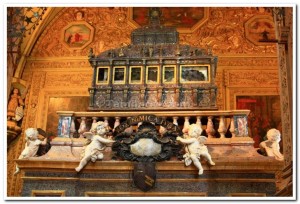 s question?
s question?
The rest of St. Francis Xavier in the Basilica of Bom Gesu in Goa, India
I dare say that we’ve all experienced something like this in our lives. Have we heard the line that the Church is in more danger of corruption from Catholics within than from non-Catholics without? There is something true in that saying I think. Yet St. Francis pressed on. His dedication to Christ Jesus was so deeply ingrained in him, that he did not need to know that all Catholics would behave properly for him to fulfill his vocation. All he needed to do was to listen to God, to press on living for Him.
Lastly, I don’t want to suggest that St. Francis was callously dismissive of the atrocities he found. Of them he wrote that they became “a permanent bruise on my soul.†He allowed the love for Christ to inform his care for his neighbor, over against those of his own faith. He wrote once, when an Indian was abducted for the slave trade,
Would the Portuguese be pleased if one of the Hindus were to take a Portuguese by force and carry him up country? The Indians must have the same feelings.
This ability of St. Francis Xavier to be driven by his compassion for his 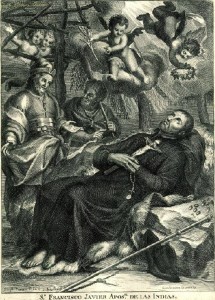 neighbor well enough to see beyond the natural affinities of nation, ethnicity, and faith… this ability to defend the rights of these downtrodden strangers, only brings me to wonder how we can be Catholic, today in the U.S., and not desire for ourselves more largeness of heart for the immigrant. Immigration is too large an issue to enter into here, but given the life of St. Francis presented above, how do we really think he would behave in our current time? Would he deny prenatal care to a woman because her proximity is illegal? Would he demand his neighbor produce proof of eligibility before offering them something as simple as shelter from the storm? No, St. Francis Xavier wouldn’t, not the great missionary, not the grand heart, not the forearm that helped to reconcile strangers in his valley of tears to the God of our homeland in the heavens.
neighbor well enough to see beyond the natural affinities of nation, ethnicity, and faith… this ability to defend the rights of these downtrodden strangers, only brings me to wonder how we can be Catholic, today in the U.S., and not desire for ourselves more largeness of heart for the immigrant. Immigration is too large an issue to enter into here, but given the life of St. Francis presented above, how do we really think he would behave in our current time? Would he deny prenatal care to a woman because her proximity is illegal? Would he demand his neighbor produce proof of eligibility before offering them something as simple as shelter from the storm? No, St. Francis Xavier wouldn’t, not the great missionary, not the grand heart, not the forearm that helped to reconcile strangers in his valley of tears to the God of our homeland in the heavens.
Perhaps, then, take time this day of St. Francis Xavier and consider the immigrant in our midst, the stranger in a strange land. If you find your heart hardened by the vituperative rhetoric that so dominates our political culture, then I ask you only to pray to St. Francis the Spaniard, St. Francis the missionary, St. Francis the lover who allowed that love to bring Jesus to the world. Perhaps we might raise a forearm, glass in hand of course, and toast with a friend the same love that saved a wretch like me.
In that spirit: St. Francis Xavier…pray for us!
 Thanks Omar for another great post!!! visit Regnum Novum for more by Omar
Thanks Omar for another great post!!! visit Regnum Novum for more by Omar
Tags: catholic, catholic podcast, catholic prayer, cathollc spirituality, china, churches in rome, india, martyr, missionary, society of jesus, st francis xavier, st. ignatius of loyola
This entry was posted on Friday, December 3rd, 2010 at 9:06 am
You can follow any responses to this entry through the RSS 2.0 feed.

